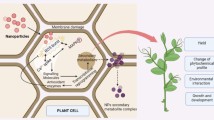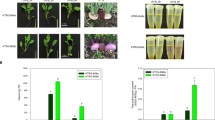Abstract
Cell suspension cultures (cell line No 615) of Catharanthus roseus cv. Little Delicata responded to elicitor treatment by accumulating monoterpenoid indole alkaloids and phenolic compounds. The excretion of phenols into the culture medium resulted from the induction of the branch-point enzyme phenylalanine ammonia lyase. The accumulation of alkaloids, however, occurred several hours earlier than the elicitor-mediated induction of tryptophan decarboxylase through which shikimate pathway intermediates are channelled into tryptamine and related indole alkaloids. The results indicate that both pathways for phenol and indole alkaloid biosynthesis responded to elicitor treatment and that no obvious causal relationship between pathways could be deduced from this study.
Similar content being viewed by others
Abbreviations
- PAL:
-
phenylalanine ammonia lyase
- TDC:
-
tryptophan decarboxylase
References
Wolters B, Eilert U (1983) Elicitoren—Auslöer der Akummulation von Pflanzenstoffen. Ihre Anwendung zur Produktionssteigerung in Zellkulturen. Dtsch Apoth Ztg 123: 659–667
DiCosmo F, Misawa M (1985) Eliciting secondary metabolism in plant cultures. Trends in Biotechnol 3: 318–322
Eilert U (1987) Elicitation: methodology and aspects of application. In: Vasil IK, Constabel F (Eds) Cell Culture and Somatic Cell Genetics of Plants. Vol 4 (pp 153–196) Academic Press/Harcourt, Bruce, Jovanovich, Publishers
Wolters B, Eilert U (1982) Acridonepoxidgehalte in Kalluskulturen von Ruta graveolens und ihre Steigerung durch Mischkultur mit Pilzen. Z Naturforsch 37C: 575–583
Eilert U, Ehmke A, Wolters B (1984) Elicitor-induced accumulation of acridone alkaloid epxides in Ruta graveolens suspension cultures. Plant Med 6: 508–512
Eilert U, Kurz WGW, Constabel F (1985) Stimulation of sanguinarine accumulation in Papaver somniferum cell cultures by fungal elicitors. J Plant Physiol 119: 65–76
Eilert U, Constabel F, Kurz WGW (1986) Elicitor-stimulation of monoterpene indole alkaloid formation in suspension cultures of Catharanthus roseus. J Plant Physiol 126: 11–22
Eilert U, Constabel F (1986) Elicitation of sanguinarine accumulation in Papaver somniferum cells by fungal homogenates—an induction process. J Plant Physiol 125: 167–172
Eilert U, De Luca V, Constabel F, Kurz WGW (1987) Elicitor-mediated induction of tryptophan decarboxylase and strictosidine synthase activities in cell suspension cultures of Catharanthus roseus. Arch Biochem Biophys 254: 491–497
Gamborg OL, Miller RA, Ojima K (1968) Nutrient requirements of suspension cultures of soybean root cells. Exp Cell Res 50: 151–158
Kurz WGW, Constabel F (1982) In: Wetter LR, Constabel F (Eds) Plant Tissue Culture Methods. 2nd edn (pp 128–131) NRCC No 19876. National Research Council of Canada, Saskatoon
Swain T, Hilli WE (1959) The phenolic constituents of Prunus domestica. J Soil Food Agric: 63–68
Farnsworth NR, Blomster RN, Damratoski D, Meer W, Cammarato LV (1964) Studies on Catharanthus alkaloids. VI. Evaluation by means of thin-layer chromatography and ceric ammonium sulfate spray reagent. Lloydia 27: 302–314
Kurz WGW (1984) Isolation and analysis of alkaloids. In: Vasil IK (Ed) Cell Culture and Somatic Cell Genetics of Plants. Vol 1 (pp 644–650) Academic Press, New York
Heinzmann U, Seitz HU (1974) Beziehung von Anthocyansynthese und Enzymaktivität der Phenylalanine-ammonium-lyase (PAL) bei Kalluskulturen von Daucus carota. Planta 117: 75–81
Bradford MM (1976) A rapid and sensitive method for the quantitation of microgram quantities of protein utilizing the principle of protein dye binding. Anal Biochem 72: 248–254
Kurz WGW (1984) Variation in indole alkaloid accumulation in cell suspension cultures from Catharanthus roseus cultivars. Proc Kyoto Symposia in Bioscience: Prospects in Plant Cell Science and Technology, Kyoto (p 11–20)
Brodelius P, Collinge MA, Funk C, Gügler K, Marques I (1989) Studies on alkaloid formation in plant cell cultures after treatment with a yeast elicitor. In: Kurz WGW (Ed) 2nd International Symposium on Primary and Secondary Metabolism of Plant Cell Cultures. Springer-Verlag, Berlin/Heidelberg (in press)
Author information
Authors and Affiliations
Additional information
Dedicated to Dr. Friedrich Constabel on the occasion of his 60th birthday
Rights and permissions
About this article
Cite this article
Seitz, H.U., Eilert, U., De Luca, V. et al. Elicitor-mediated induction of phenylalanine ammonia lyase and tryptophan decarboxylase: Accumulation of phenols and indole alkaloids in cell suspension cultures of Catharanthus roseus . Plant Cell Tiss Organ Cult 18, 71–78 (1989). https://doi.org/10.1007/BF00033466
Received:
Accepted:
Issue Date:
DOI: https://doi.org/10.1007/BF00033466




